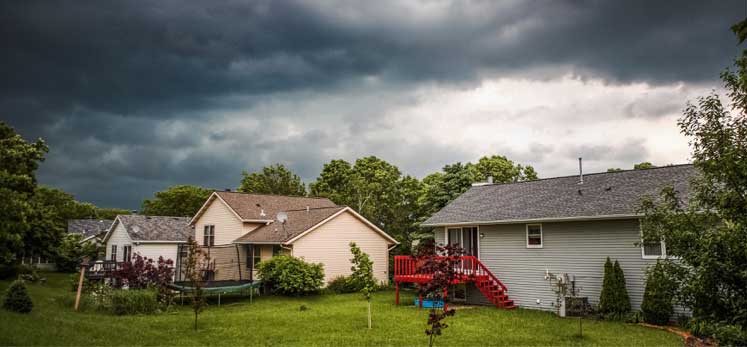
Once you become a homeowner, you realize just how many hazards threaten the stability and safety of your investment. In particular, harsh weather conditions can impact your home in various ways. Try these five tips to protect your home and property more effectively against environmental threats.
1. Reduce Fire Hazards in Your Home
While fire doesn’t usually result from severe weather conditions, it is an environmental threat that can damage or destroy your home. You can reduce a home fire’s risks with simple safety measures. For example, occasionally inspecting your home’s wiring can identify shorts.
Many house fires start in the kitchen. Avoid leaving your kitchen unattended when cooking. Ensure you keep a class B fire extinguisher in your kitchen to put out oil and grease fires. You should also have fire extinguishers in bedrooms and common areas. Test your home’s smoke alarms every six months to ensure the batteries are in good condition.
2. Check Your Home’s Exterior Before a Rainstorm
There are several ways that a storm can lead to exterior house damage. Keeping up with roof maintenance is one important step in preventing damage since a weak roofing section can expose the inside of your home to rain and debris.
If a storm damages your roofing materials, a roof tarp and board-up service can help protect your home in an emergency. Make sure you look into How to Tarp a Roof beforehand. Schedule semi-annual roof inspections to catch issues early. Additionally, keep an eye on nearby trees. Dead branches or long limbs will likely break during a storm. If a tree is close to your home, a broken tree branch can damage your roof, siding, or windows. Always secure garbage cans, bicycles, and other equipment that you leave stored outdoors.
3. Guard Your Windows and Doors to Prevent Hail Damage
Keeping up with roof maintenance will also help you prevent the need for hail damage repairs. If your home has a flat roof, investing in a sloped roof can help you minimize damage in an area with frequent hail storms. And if you have a skylight or plan to install one, ask your contractor to use impact-resistant glass.
You’ll also protect your home by installing shutters on your windows. While many homebuilders install shutters, some houses do not have them. If your home doesn’t have shutters, investing in them can save your windows from repeated damage. Close them during any storm to get the best protection from them.
4. Know How to Protect Your Home from Flooding
Water damage can result from storms or plumbing issues, and it’s essential to get this type of damage repaired immediately. Otherwise, the moisture can lead to mold growth, bringing many health and home maintenance issues. Keep your gutters in good condition to help control water flow during a storm.
You should also look at the contour of the land surrounding your home. If your house is close to a slope or hill, you may need to find ways to divert the flow of rainwater. Inside your home, install a sump pump in your basement, and make sure it remains in good condition. Basement waterproofing can also help you keep your home dry when flooding conditions are present.
5. Stay Alert to the Damages Caused by High Winds
Recognizing that your home can suffer storm damage even without heavy rainfall is essential. High winds can cause damage to your home by tearing up loose roofing materials or blowing loose objects against your house. This damage is easily prevented by securing patio furniture and similarly loose items.
You can also use landscaping to protect your home during any storm. Tall shrubs and trees can serve as barriers that will block your home from wind damage. If you keep trees and foliage trimmed and healthy, they can be helpful during a storm. Additionally, you can use solid retaining walls or concrete barriers instead of chain link fences for better protection.
Diligence Is the Key to Protecting Your Home
Keeping up with your home’s maintenance can help protect your property from bad weather conditions. Schedule routine inspections, watch for signs of decay or rot, and get repairs done promptly. By diligently looking after your home, you can keep it stronger, more durable, and better able to stand up against severe environmental conditions.
Jordan Avery
Related posts
Stay connected
- How LoveOn Chat Is Becoming the Most Versatile AI Companion for Digital UsersThe internet keeps shifting toward hyper-personal interaction, and AI companions are at the center of this shift. What used to be simple chatbots are now evolving into emotionally aware, adaptive, and multi-functional digital partners. Among the new generation of platforms, LoveOn Chat is becoming one... The post How LoveOn Chat Is Becoming the Most Versatile […]
